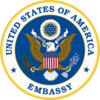US Embassy, Saigon
| Embassy of the United States, Saigon | |
|---|---|
|
Native name Vietnamese: Đại sứ quán Hoa Kỳ, Sài Gòn |
|
 
The Second Embassy exterior as viewed from the street
|
|
| Location | Saigon, South Vietnam |
| Coordinates | 10°47′00″N 106°42′01″E / 10.7833°N 106.7004°ECoordinates: 10°47′00″N 106°42′01″E / 10.7833°N 106.7004°E |
| Area | 3.18 acres (12,900 m2) (Second Embassy |
| Demolished | June 1998 |
| Architect | Adrian Wilson and Associates (Second Embassy only) |
| Governing body |
|
| Opened | June 24, 1952 |
| Closed | April 30, 1975 |
| Ambassador |
Donald R. Heath (first) Graham Martin (last) |
| Address | 39 Hàm Nghi Boulevard (First Embassy) 4 Thống Nhứt (Second Embassy, current street name is 4 Lê Duẩn) |
The United States Embassy in Saigon was first established in June 1952, and moved into a new building in 1967 and eventually closing in 1975. The embassy was the scene of a number of significant events of the Vietnam War, most notably the Viet Cong attack during the Tet Offensive which helped turn American public opinion against the war, and the helicopter evacuation during the Fall of Saigon after which the embassy closed permanently.
In 1995, the U.S. and the Socialist Republic of Vietnam formally established relations and the embassy grounds and building were handed back to the United States. The former embassy was subsequently demolished in 1998 and is currently a park inside of the compound of the U.S. Consulate General in Ho Chi Minh City.
The U.S. diplomatic presence in Saigon was established on December 9, 1907 as a consulate. It acted as a representative to French Indochina succeeding an American commercial agent that had been established in Saigon in 1889. The United States granted recognition to the State of Vietnam led by the Bảo Đại government in 1950, and on February 17, the Consulate-General in Saigon was elevated to Legation status with Edmund A. Gullion as Chargé d'Affaires ad interim. Following the Geneva Accords of 1954 and the subsequent partitioning into North Vietnam and South Vietnam, the United States did not extend diplomatic recognition to North Vietnam. On June 24, 1952, after the U.S. Senate confirmed Donald R. Heath as the U.S. Ambassador to South Vietnam, the Legation in Saigon's status was raised and the embassy was formally established. The first embassy was located at 39 Hàm Nghi Boulevard and the original building remains there today.
On March 30, 1965, the Viet Cong detonated a car-bomb outside the embassy. The attack occurred when a Vietnamese policeman began arguing with the driver of a car parked in front of the embassy but the driver refused to leave and then another Viet Cong member drove up alongside the car and fired on the policeman. Quickly following the brief exchange of fire, the car, which contained 300 pounds of plastic explosives, detonated in front of the embassy killing two Americans, one female CIA employee, Barbara Robbins and another American, as well as 19 Vietnamese and one Filipino serving in the U.S. Navy along with injuring 183 others. The U.S. Congress appropriated $1 million to reconstruct the embassy in a new location following the attack and although retaliatory raids on North Vietnam were suggested, U.S. President Lyndon Johnson refused. Following the attack, South Vietnamese Foreign Minister Tran Van Do posthumously decorated Barbara Robbins and the Filipino navy serviceman with the Medal of Honor First Class.
...
Wikipedia

